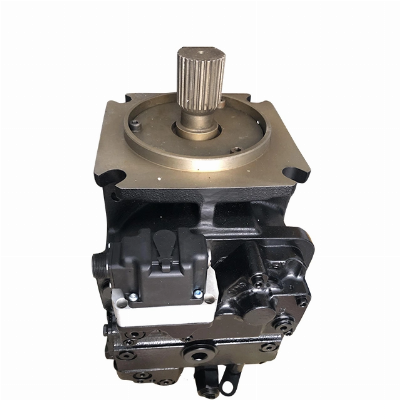Sauer 90R Hydraulic Piston Pump Product
DescriptionSeries 90 axial piston variable displacement pumps are
of cradle swash plate design with variable displacement, and are
intended for closed circuit applications. The flow rate is
proportional to the pump input speed and displacement. The latter
is infinitely adjustable between zero and maximum displacement.
Flow direction is reversed by tilting the swash plate to the
opposite side of the neutral (zero displacement)
position. Sauer 90 Series Hydraulic Piston Pump Feature1.The
Series 90 - Advanced Technology Today ;2. 8 Sizes of Variable
Displacement Pumps ;3. Complete Family of Control SystemsProven
Reliability and Performance ;4. Product Configurations ;5. Compact
and Lightweight. Product ParametersTable of values
(theoretical values, without efficiency and tolerances; values
rounded)Sauer
90Dimension90R03090L03090R04290L04290R05590L05590R07590L07590R10090L10090R13090L13090R18090L18090R25090L250Displacementcm330425575100130180250in31.832.563.354.576.17.9310.9815.25Input
speedMinimummin-1 (rpm)500500500500500500500500Ratedmin-1 (rpm)4
2004 2003 9003 6003 3003 1002 6002 300Maximummin-1 (rpm)4 6004
6004 2503 9503 6503 4002 8502 500Max.
Attainablemin-1 (rpm)5 0005 0004 7004 3004 0003 7003 1502
750TheoreticalNm/bar0.480.670.881.191.592.072.873.97Torquein
lb/1000 psi2904105307309701 2601 7502 433Mass moment of inertia of
the int. rotating partskg
m20.00230.00390.0060.00960.0150.0230.0380.065lb •
ft20.05460.09260.14240.2280.3560.5460.9021.543Weight (with MA
Control)kg283440496888136154lb627588108150195300340
Detailed PhotosControls - Circuit Diagram, Nomenclature and
Description, 3-Position (FNR) Electric Control, Options DC, DDThe
3-Position (FNR) control uses an electric input signal to switch
the pump to a full stroke position.A range of orifice sizes is
available for the Series 90 Electric Displacement Control to assist
in matching the rate of swash plate response to the acceleration
and deceleration requirements of the application. Testing should be
carried out to determine the proper orifice selection for the
desired response.Electric Displacement Control (EDC), Options KA,
KPThe electric displacement control uses an electro-hydraulic
Pressure Control Pilot valve to control the pilot pressure. The
Pressure Control Pilot valve converts an electrical input signal to
a hydraulic input signal to operate a 4-way servo valve, which
ports hydraulic pressure to either side of a double acting servo
piston. The servo piston tilts the cradle swash plate, thus varying
the pump's displacement from full displacement in one direction to
full displacement in the opposite direction. The control has a
mechanical feedback mechanism which moves the servo valve in
relation to the input signal and the angular position of the swash
plate. The electrical displacement control is designed so the
angular rotation of the swash plate (pump displacement) is
proportional to the electrical input signal. Due to normal
operating force changes, the swash plate tends to drift from the
position preset by the machine operator. Drift, sensed by
feedback linkage system connecting the swash plate to the control
valve, will activate the valve and supply pressure to the servo
piston, maintaining the swash plate in its preset
position.Hydraulic Displacement Control (HDC), Option HFThe
hydraulic displacement control uses a hydraulic input signal to
operate a 4-way servo valve, which ports hydraulic pressure to
either side of a double acting servo piston. The servo piston tilts
the cradle swash plate, thus varying the pump's displacement from
full displacement in one direction to full displacement in the
opposite direction. The control has a mechanical feedback mechanism
which moves the servo valve in relation to the input signal and the
angular rotation of the swash plate. The hydraulic
displacement control is designed so the angular position of
the swash plate (pump displacement) is proportional to the
hydraulic input signal pressure. Due to normal operating force
changes, the swash plate tends to drift from the position preset by
the machine operator. Drift, sensed by feedback linkage system
connecting the swash plate to the control valve, will activate the
valve and supply pressure to the servo piston, maintaining the
swash plate in its preset position.Manual Displacement Control
(MDC), Options MA, MBThe manual displacement control device
converts a mechanical input signal to a hydraulic signal that tilts
the cradle swash plate through an angular rotation varying the
pump's displacement from full displacement in one direction to full
displacement in the opposite direction. The manual displacement
control has a mechanical feedback mechanism which moves a servo
valve in the proper relationship to the input signal and the
angular position of the swash plate. The manual displacement
control is designed so that the angular rotation of the swash plate
is proportional to the mechanical input signal.
Related products about High Quality Disreplacment 90r055 Hydraulic Axial Piston Pump
-
 Waste Tyre Plastic Recycling Machinery Machine Tire Crusher Production Line Rubber Crumb Grinding Machine Equipment Tire Shredder
Waste Tyre Plastic Recycling Machinery Machine Tire Crusher Production Line Rubber Crumb Grinding Machine Equipment Tire Shredder
-
 Stretch Plastic Blowing Pet Bottle Making Blow Molding Machine Bottles Stretch Automatic Pet Bottle Blowing Machine
Stretch Plastic Blowing Pet Bottle Making Blow Molding Machine Bottles Stretch Automatic Pet Bottle Blowing Machine
-
 Waste Plastic Pet Bottle, Water Bottle Flake, PP/HDPE/LDPE PE Film Jumbo Woven Bags Plastic Crusher Machine, Plastic Crushing Washing Recycling Machine
Waste Plastic Pet Bottle, Water Bottle Flake, PP/HDPE/LDPE PE Film Jumbo Woven Bags Plastic Crusher Machine, Plastic Crushing Washing Recycling Machine
-
 Type 2 Wall-Mounted Electric Car Charging Station 7kw /11 Kwelectric Vehicle Charging Station Home Wallbox AC EV Charger Single Phase or 3three Phase
Type 2 Wall-Mounted Electric Car Charging Station 7kw /11 Kwelectric Vehicle Charging Station Home Wallbox AC EV Charger Single Phase or 3three Phase
-
 G-View G12W Wholesale Auto Car LED Headlight Bulb High Power H13 H11 9005 H7 H4 Car LED Headlights LED Car Lights
G-View G12W Wholesale Auto Car LED Headlight Bulb High Power H13 H11 9005 H7 H4 Car LED Headlights LED Car Lights
-
 New Design Porcelain Round Plates Dinner Set for Wedding and Banquet
New Design Porcelain Round Plates Dinner Set for Wedding and Banquet
-
 China 2023 New Design Super Soft 100% Polyester Microfiber Knitted Oversized Decoration Hoodie Blanket
China 2023 New Design Super Soft 100% Polyester Microfiber Knitted Oversized Decoration Hoodie Blanket
-
 Handmade Art Creative Materials Thickened White Paper Cup DIY Disposable Handmade Colored Paper Cup
Handmade Art Creative Materials Thickened White Paper Cup DIY Disposable Handmade Colored Paper Cup






